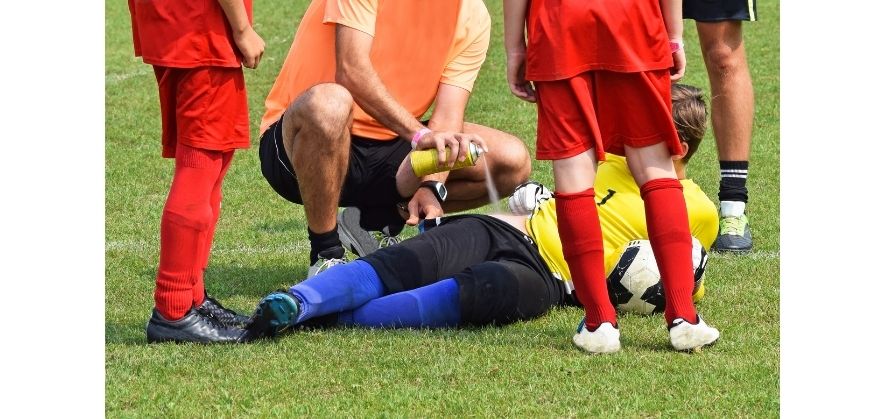It’s pretty rare to see a first half or second half in soccer end exactly on the respective 45- and 90-minute marks.
Soccer matches are quite intense, and within passages of play there are various stoppages that take place as the clock runs down.
When games draw towards their conclusion, referees usually tack on a couple of extra minutes in order to account for earlier breaks in play.
In the sportsmanlike spirit of the sport, additional time helps to keep the game fair.
One question that’s regularly raised by fans who are new to the sport is why the match officials add on some extra minutes.
So, this article has been written to explain this phenomenon in greater detail.
Let’s begin with a quick summary…
Soccer referees add time in matches to account for stoppages and delays that occur during each half. This could be because of the wasted time a team took when making player substitutions, or because of player injuries sustained in the course of the game which required medical treatment that ran the clock down.
But the list of reasons doesn’t end there.
Read on to get the complete picture.
Reasons why referees add more time in soccer
There are so many factors at play that can determine what length of time a referee chooses to add on at the end of each half.
In fact, the Football Association is quite clear on this:
“Allowance is made by the referee in each half for all playing time lost in that half through substitutions; assessment and/or removal of injured players; wasting time; disciplinary sanction; medical stoppages permitted by competition rules e.g. ‘drinks’ breaks (which should not exceed one minute) and ‘cooling’ breaks (ninety seconds to three minutes); delays relating to VAR ‘checks’ and ‘reviews’, any other cause, including any significant delay to a restart (e.g. goal celebrations)”
Source – Law 7 on the duration of a match
Now let’s go through some of the aforementioned points.
1. Player substitutions

Teams are allowed to replace their starting players during the course of games.
Depending on the competition that a club is participating in, they will have the choice to substitute three or more players within the duration of the 90 minutes.
Sometimes players are simply fatigued and need to be replaced with someone who has “fresh legs”.
In other instances, a player may have picked up a groin or a hamstring injury which makes them unable to carry on competing.
Substitutions have worked in the past and the action continues to revitalize teams and give them a stronger impetus to go on and secure a positive result.
When a substitution happens, the player who is being taken off has to walk from their location on the field all the way to the dugout where their team mates are sat.
This can take up to two minutes of official game time depending on how far they’re situated from the touchline.
Because play can only resume after the replacement has entered the field, substitutions take up time that could be spent competing.
So, referees usually add on some extra time (e.g. about thirty seconds to a minute each) to account for this type of disruption in play.
2. Injuries and subsequent player treatment

At times, soccer can be a very physical game.
Players who participate in their sport have to put their bodies on the line when match situations call for it.
Say for example, a goal kick is taken and two players (one from each team) have to jump up to head the ball.
There’s a decent possibility of a player picking up an injury if they receive a blow to the body in the process of contesting this aerial challenge.
You could be looking at any of the following things in such a scenario:
- A knock to the skull which causes disorientation at best and concussion at worst;
- A scratch to the face which results in heavy bleeding; or even
- A hit to the chest cavity that leads to a shortness of breath
All of these injuries may require an extended amount of time for a player to recover.
If a manager doesn’t want to substitute that player at the time they were injured, then a group of qualified physios will attend to them whilst they lie down on the pitch.
At this point, the medical team will do all that they can to treat the injuries that the player has suffered, and in that time the match will stop.
Because of the generally lengthy stoppage in play that happens due to injuries and subsequent treatment, referees account for the time lost by adding on some extra minutes at the end of the half.
3. Time wasting
Another reason why referees need to add time is because of time wasting tactics that are sometimes employed by players of either team.
Soccer is a very results-oriented sport.
Securing a win or a draw could be the difference between promotion to a division with higher financial rewards and remaining stagnant as a club.
That’s why players occasionally resort to unorthodox courses of action in order to ensure their team gets the result that it needs.
One of these ways is through wasting time.
For example, a goalkeeper could decide to hold onto the ball in their penalty area for a long time before releasing it.
That would constitute time wasting as they’re gaining an advantage for keeping possession of the ball for longer than necessary.
On that note, we have an informative article which explains how long a goalkeeper is allowed to hold on to a soccer ball for.
You can check it out when you’ve got some spare time!
Another way in which a team can try to run down the clock is by taking too long to throw the ball back in to play after it exited the field.
Or even worse, a player could instruct a ball boy not to run after a soccer ball when they want to retrieve it.
Below is a video compilation of all the creative ways that soccer players use to waste time during matches:
Referees take note of all these strategic actions and add on extra time to the end of a half to compensate for time wasting.
4. Fouls

Fouls are part and parcel of the beautiful game.
Sometimes, a player will attempt to regaining possession of the ball from their opponent.
And in the process of doing so, they could end up tripping an opposition player or causing them harm.
That’s where referees blow their whistle to temporarily stop the game for a foul.
But soccer players are known to be dramatic characters, so in some instances they can pretend to be injured in order to help their team.
Referees are aware of this and they deal with this type of game delay by adding on more time.
A general rule of thumb for a referee is to add on five to 10 extra seconds for each foul that’s occurred in a half.
5. Goal celebrations

Scoring the winning goal in a crucial fixture can bring moments of immense joy for players.
This can lead to lengthy player celebrations where players end up running all the way to the fans located at the far corner of the stadium, or even going to high-five their coaches back in the technical area.
Because some time is lost before the match restarts from the center circle, referees tend to add on an extra 30 seconds to make up for the duration of time that was spent celebrating.
When was the added time concept introduced to the sport?
The first instance of this concept being used in the game happened in the year 1891 – a clash between Stoke City and Aston Villa.
With the latter team leading with just two minutes of official time left to play, Stoke City were given a penalty.
But what happened next was quite hilarious.
An Aston Villa player kicked the ball high and out of the stadium which prevented Stoke from taking the spot kick.
Sadly, by the time the soccer ball was recovered from outside the ground, the 90 minutes were already up and the game ended without the penalty being taken!
That caused the sport’s lawmakers to reform this aspect of the game, and it was later on that they decided to incorporate the added time concept to ensure such scenarios were a thing of the past.
How is added time determined?
Referees don’t just decide how much time to add at the end of halves off the top of their head.
They use their watches to keep track of the amount of time that ends up being lost during a match.
In fact, referees wear two watches partly for this reason, as they can use one watch to not how much time is lost to stoppages and delays whilst keeping the other one running.
Once the half is about to end, they tally up both times and note the numerical difference between the two watches, as that’s the amount of extra time that they will add on.
After they’ve determined the amount of time to add on, that information is relayed to the fourth official on the side lines, who then inputs that figure into their electronic board and subsequently raises it to indicate to the players on the pitch how much time they have left to compete.
Closing thoughts
That marks the end of this post on why referees add time in soccer.
Hopefully it will have enlightened you on this area of the game.
Should you wish to read about something similar, then have a look at our article that explores why soccer games get extra time after the normal 90 minutes of play.
Alternatively, if you like refereeing and enjoy doing it, you can check out our other article on the finest soccer referee watches, as you’ll definitely need one to keep track of time during games.
If you enjoy the content that I create and would like to buy me a coffee, then I’d really appreciate it!
Any money that I earn through this donation will be re-invested into more content for this website.
Additionally, by sending in a donation you’ll also receive a copy of my recently released 190+ page eBook on Soccer Ball Care, as well as be subscribed to our mailing list where you’ll be regularly informed on the latest developments concerning the Soccer Whizz blog.
- Future Icons: Europe’s Emerging Midfield Maestros Set for Glory - December 4, 2023
- Kickstarting a Revolution: How Soccer Transformed the United States Over the Last Four Years - October 7, 2023
- 4-1-4-1 Soccer Formation [Analysis] - September 23, 2023

